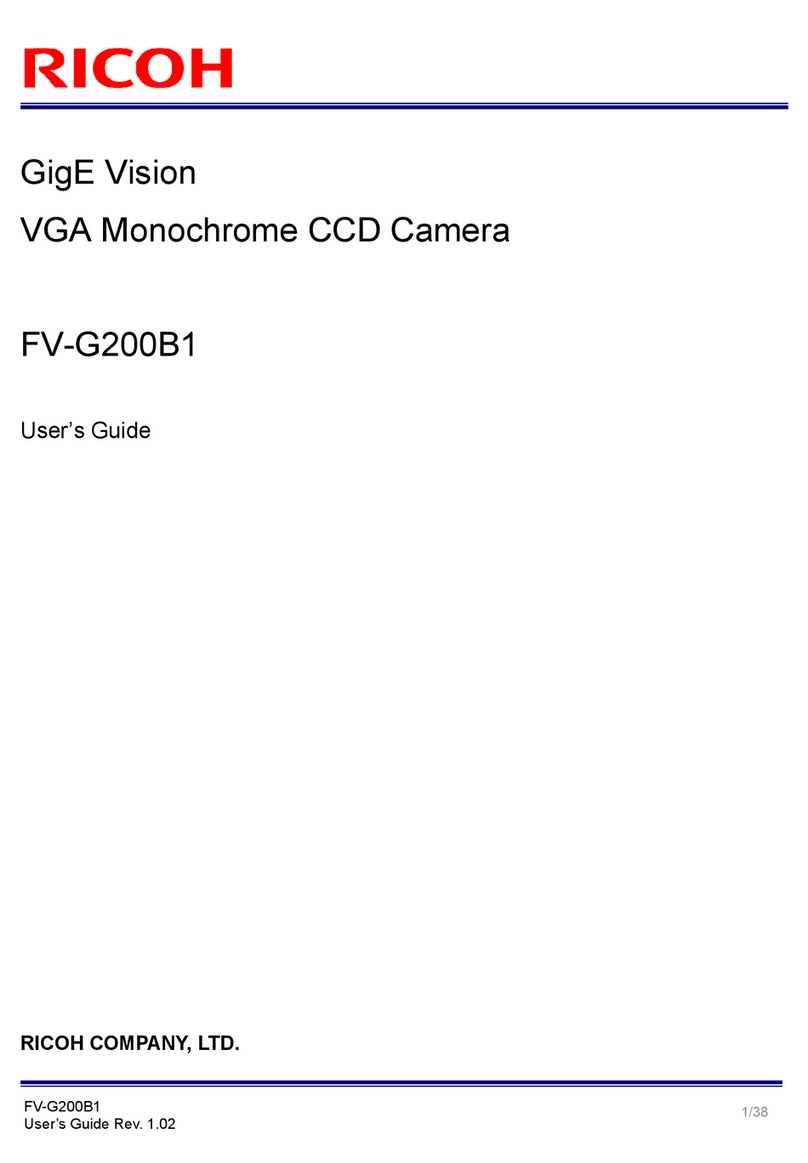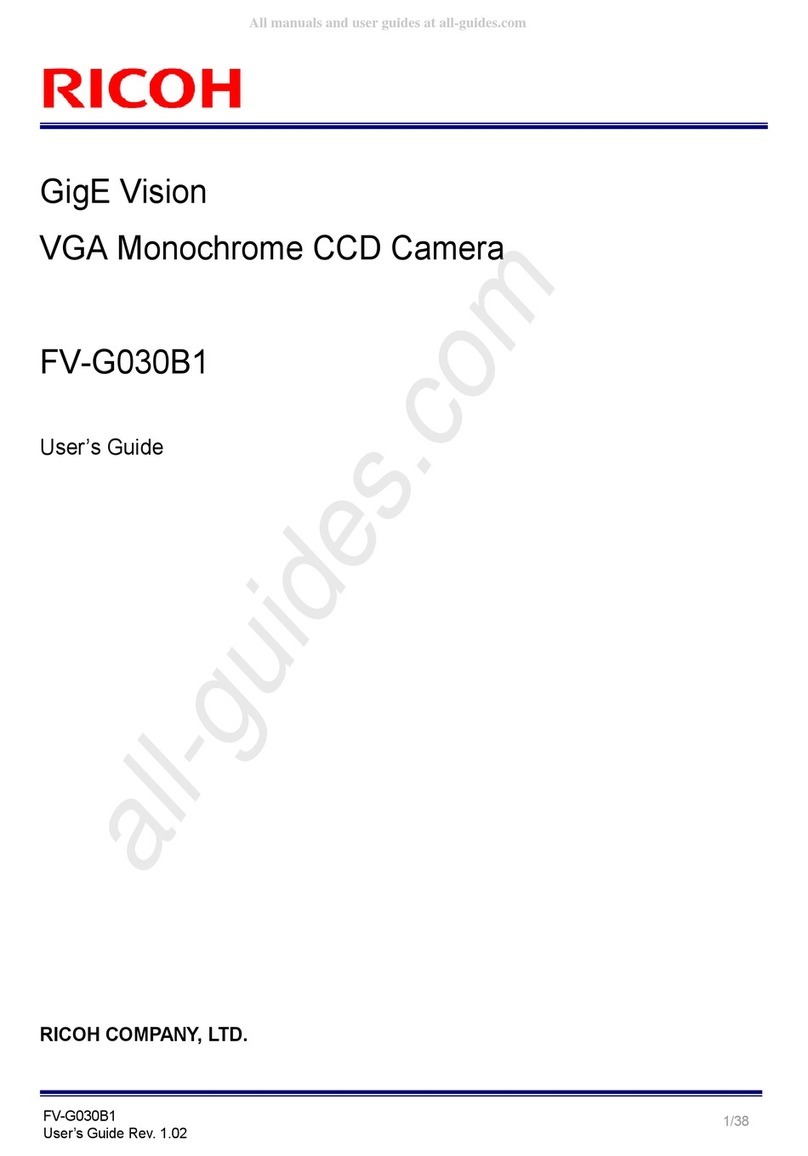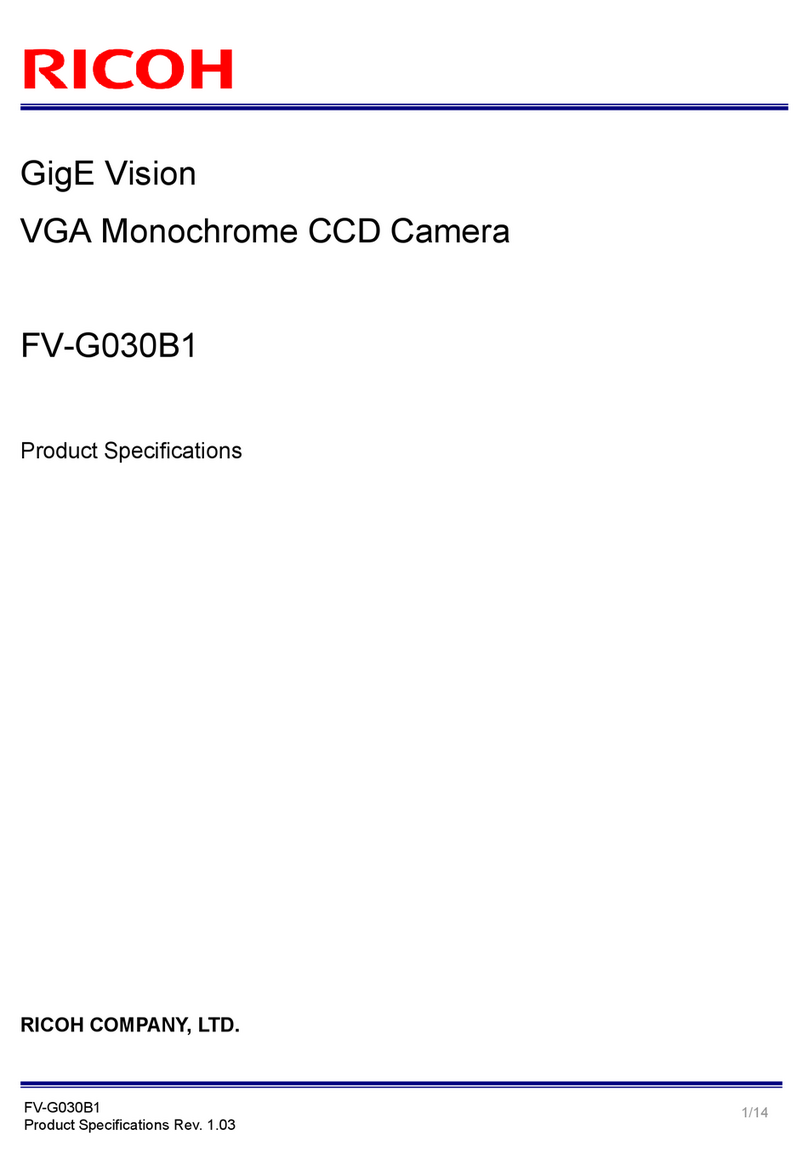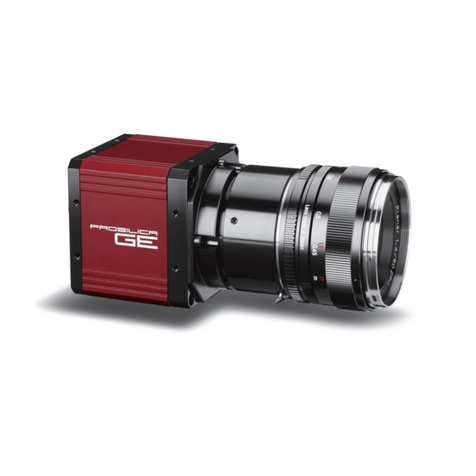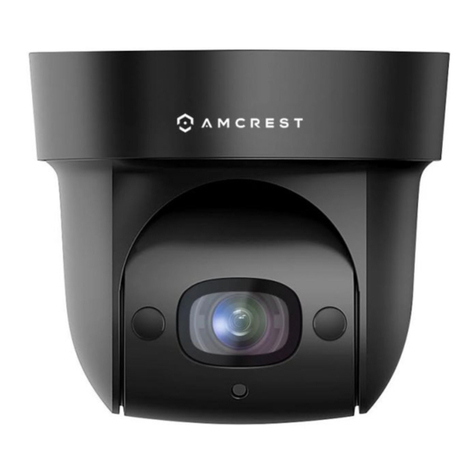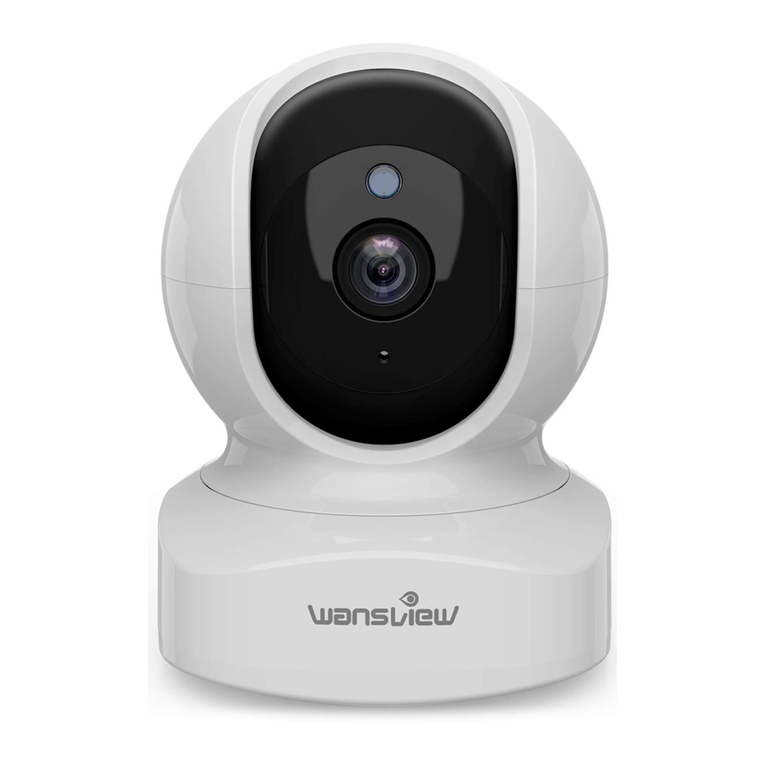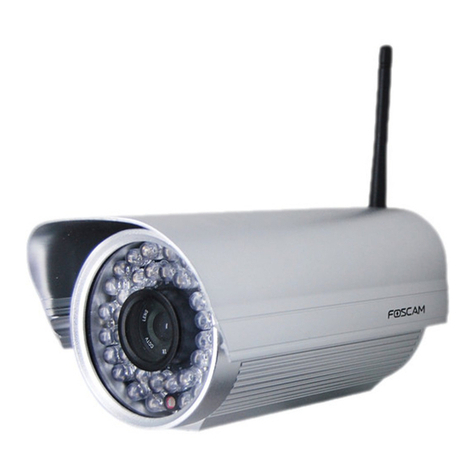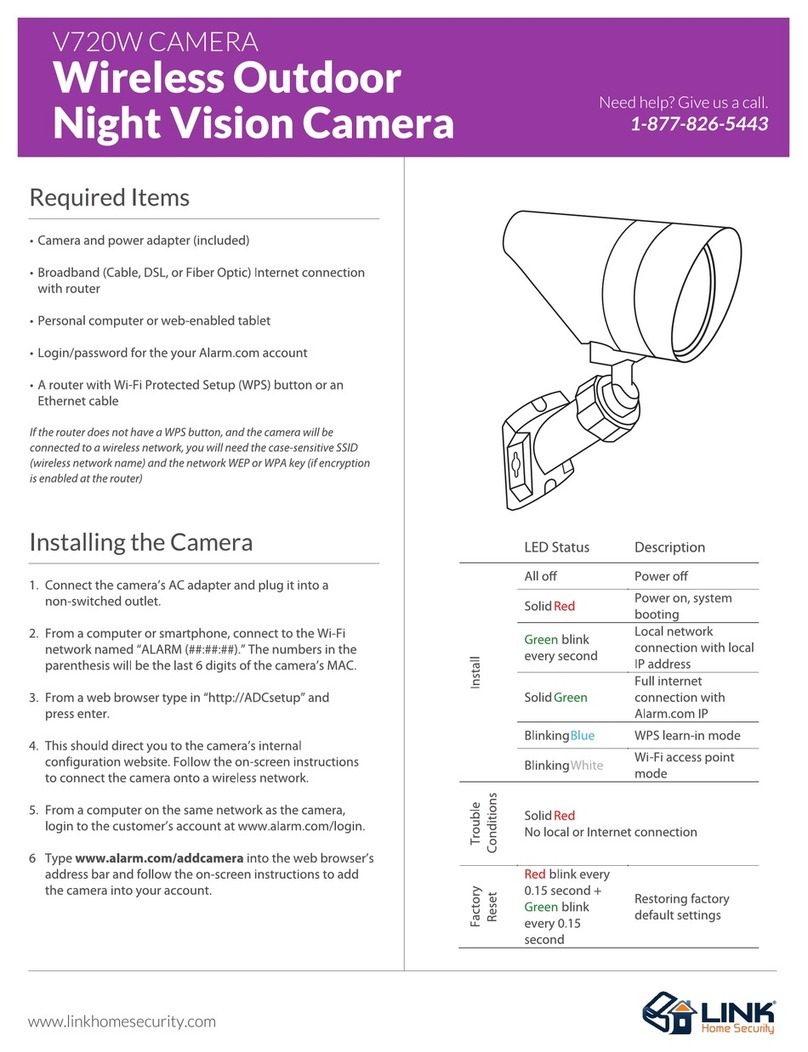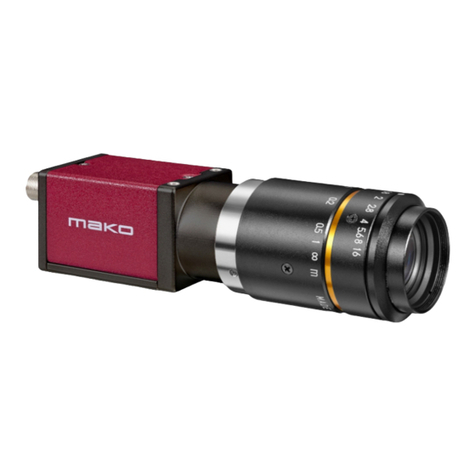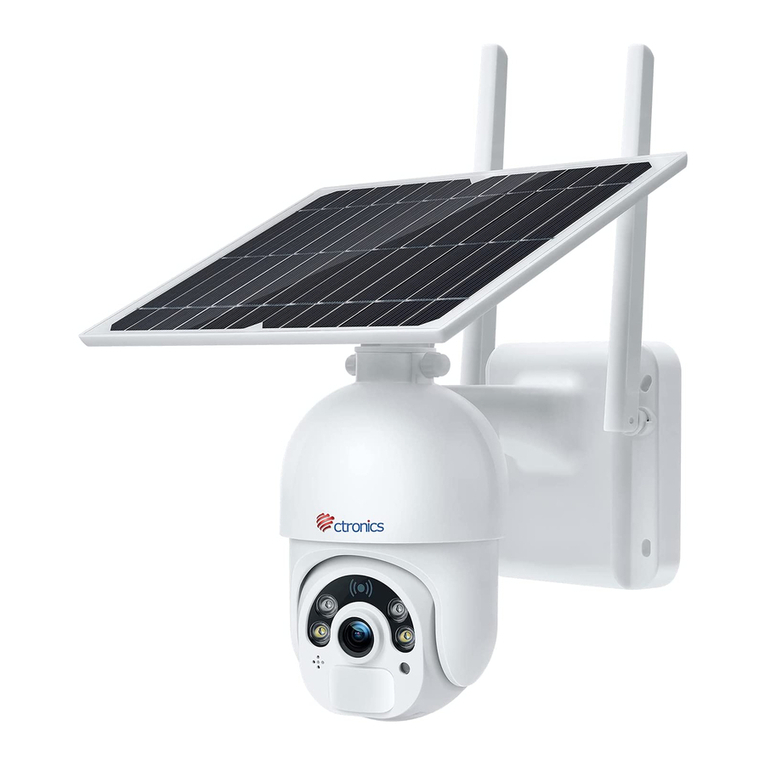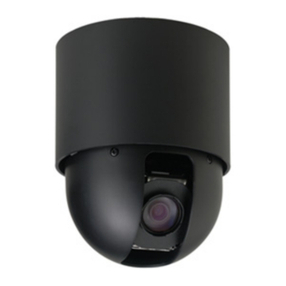Ricoh FV-G030B1 User manual

1/37
FV-G030B1
User’s Guide Rev. 1.01
GigE Vision
VGA Monochrome D amera
FV-G030B1
User’s Guide
RICOH COMPANY, LTD.

2/37
FV-G030B1
User’s Guide Rev. 1.01
Table of Contents
1 Connector Specifications.....................................................................................................................................
1.1
RJ45 onnector ...................................................................................................................................................... 3
1.2
D Iris Lens onnector .......................................................................................................................................... 4
1.3
Power-I/O onnector .............................................................................................................................................. 4
1.3.1
Equivalent ircuit for the Input Pin of the I/O onnector .................................................................................... 6
2 Camera Output Timing Charts .............................................................................................................................7
2.1
Horizontal Timing .................................................................................................................................................... 7
2.2
Vertical Timing......................................................................................................................................................... 7
2.2.1
Full Scanning....................................................................................................................................................... 7
2.2.2
AOI (Area of Interest) .......................................................................................................................................... 8
2.3
Pixel Transferring Image......................................................................................................................................... 9
Camera Operational Modes................................................................................................................................10
3.1
Normal Mode ........................................................................................................................................................ 10
3.2
Pulse Width Trigger Mode .................................................................................................................................... 10
3.2.1
Timing................................................................................................................................................................ 10
3.2.2
Exposure Timing with the Positive Polarity Trigger Signal.................................................................................11
3.2.3
Exposure Timing with the Negative Polarity Trigger Signal ...............................................................................11
3.3
Edge Preset Trigger Mode.................................................................................................................................... 12
3.3.1
Timing................................................................................................................................................................ 12
3.3.2
Exposure Timing with the Positive Polarity Trigger Signal................................................................................ 13
3.3.3
Exposure Timing with the Negative Polarity Trigger Signal .............................................................................. 13
3.4
Edge Preset Trigger Mode (Trigger Input While the Image Is Out) ...................................................................... 14
3.4.1
Timing................................................................................................................................................................ 14
3.4.2
Exposure Timing with the Positive Polarity Trigger Signal................................................................................ 15
3.4.3
Exposure Timing with the Negative Polarity Trigger Signal .............................................................................. 15
3.5
H Reset Mode ....................................................................................................................................................... 16
4 Communication Protocol....................................................................................................................................17
4.1
ommunication Method........................................................................................................................................ 17
4.2
ommunication Settings....................................................................................................................................... 17
4.3
ommunication Format ........................................................................................................................................ 17
4.4
amera ontrol ommand................................................................................................................................... 20
4.4.1
amera ommand List (Device ode: 000000) ............................................................................................... 20
4.4.2
amera ommand List (Device ode: 100000) ............................................................................................... 22
4.4.3
Descriptions of the amera ontrol ommands (Device code: 000000);........................................................ 24
4.4.4
Descriptions of the amera ommands (Device code: 100000);..................................................................... 30
4.5
GenI am ommand / amera ommand Reference Table ................................................................................ 34

3/37
FV-G030B1
User’s Guide Rev. 1.01
1 Connector Specifications
1.1 RJ45 onnector
This product is NOT a PoE type. Apply power (+10.8 to +26.4Vdc) ONLY through the I/O connector.
Pin Assignment: LED Information:
Pin No. Signal Name
1 TA+
2 TA-
3 TB+
4 T +
5 T -
6 TB-
7 TD+
8 TD-
Please use a 1Gb supported NIC, HUB and LAN cable. Check that the NIC and HUB being used is “1Gb
transferring”.
Damaging or mishandling the CAT5e cable may cause the transferring speed to change from 1Gb to 100Mb.
If this happens, please replace the CAT5e cable.
Green LED Yellow LED Status
Green Light ON Orange Light ON Power ON
Green Light ON Orange Light Blinking 1Gb Transferring
Light OFF Orange Light Blinking 100 Mb Transferring
Power-I/O onnector
D Iris Lens onnector
RJ45 onnector
The camera is powered-on Green light: ON
Yellow light: Blinking
1 Gb Transferring
Green light: OFF
Yellow light: Blinking
100 Mb Transferring

4/37
FV-G030B1
User’s Guide Rev. 1.01
1.2 D Iris Lens onnector
M1951 (EMUDEN) or equivalent.
Pin Assignment
Pin No. Signal Name
1 DAMP-
2 DAMP+
3 DRIVE+
4 DRIVE-
1.3 Power-I/O onnector
HR10A-7R-6PB(Hirose)or equivalent
This connector is for the power supply (12Vdc) and input /output signals.
Use HR10A-7P-6S (Hirose) or equivalent for the cable side.
Pin Assignment
Output signals can be assigned through the camera setting communication.
(Device ode = 00H, ommand = F0H and F1H)
IO Signal Patterns for Pin No.2 (I/O-1) and Pin No.3 (I/O-2)
Pin No.
Signal Name
IN / OUT
Voltage
1 GND IN 0V
2 I/O-1 OUT +3.3V LVTTL
3 I/O-2 OUT +3.3V LVTTL
4 TRG_In- IN Smaller than 1.0V (Opt. Isolated -)
5 TRG_In+ IN +3.0 to +26.4V (Opt. Isolated +)
6 POWER IN IN +10.8 to +26.4 Vdc
Command No. HR10A-7R-6PB (Hirose)
F0H[ ..0] F1[ ] F0H[7..4] F1[4]
For I/O-1 (Pin No. 2) For I/O-2 (Pin No. ) I/O-1 (Pin No.2) / I/O-2 (Pin No. )
0H
(initial setting) - 0H - FrameTriggerWait
(initial setting for I/O-1)
1H Set Value 1H Set Value UserOutput
2H - 2H
(initial setting) ExposureActive
(initial setting for I/O-2)
3H - 3H - TriggerAuxiliary
4H - 4H TriggerInternal
5H - 5H SensorReadOut
6H - 6H StrobeSignal
7H-FH - 7H-FH - For Test Use Only
1 2
3 4

5/37
FV-G030B1
User’s Guide Rev. 1.01
Note: I/O-1 can be assigned only by F0H[3..0] and F1[3], and I/O-2 can be assigned only by F0H[7..4] and F1[4].
1) FrameTriggerWait
The user can check the camera condition (camera exposure and image output processing by the trigger signal with
this FrameTriggerWait signal).
This signal is LOW for the period from the trigger input signal to the image output.
a) High status (3.3V): No processing by the trigger signal. The camera accepts the trigger signal.
b) Low status (0V): The camera is exposed and the image output processes by the trigger signal.
The camera default setting is the input trigger signal is INVALID while at the low status of this signal. When the
exposure starts while the image output by the next trigger signal, please change the camera setting (Device code:
00H, ommand No. :13H) to accept the trigger signal while the image outputs.
The noise appears on the image when the exposure begins while the image is output. The noise appears on the
image when the start exposure while the image is output. In this case, please change the “H reset” for the exposure
start mode (Device code: 00H, ommand No. : 12H) to change the exposure start point to the next HD timing.
2) UserOutput
The status of the UserOutput signal can change with the “UserOutputValue”.
a) High status (3.3V)
b) Low status (0V).
3) ExposureActive
The user can check the exposure time with the ExposureActive signal.
a) High status (3.3V): The camera is exposing
b) Low status (0V): The camera is not exposed
4) TriggerAuxiliary
The TriggerAuxiliary signal is the input trigger signal.
5) TriggerInternal
The TriggerInternal signal is the input trigger signal with the trigger delay time.
6) SensorReadOut
The SensorReadOut signal is the FVAL signal, which is the image output period of the time.
7) StrobeSignal
The StrobeSignal signal is the strobe control signal.

6/37
FV-G030B1
User’s Guide Rev. 1.01
1.3.1
Equivalent ircuit for the Input Pin of the I/O onnector
+3.3V
+3.3V
+3.3V
TOSHIBA RN1105MFVTOSHIBA RN1105MFV
2
1 3
TOSHIBA TLP181TOSHIBA TLP181
34
6 1
2.2K2.2K
1
2
3
4
5
6
TOSHIBA RN1105MFVTOSHIBA RN1105MFV
2
1 3
1K1K
1K1K
+10.8 to +26.4V
Trigger_In+
Trigger_In-
IO_Out
IO_Out
GND
ustomer GND
+3 to +26.4V
3 to 5mA
Trigger Signal
HR10A-7R-6PB (HIROSE)
or equivalent connector

7/37
FV-G030B1
User’s Guide Rev. 1.01
2 Camera Output Timing Charts
2.1 Horizontal Timing
1 LK = 27.1605 nseconds
2.2 Vertical Timing
2.2.1
Full Scanning
1 H = 21.1852 µseconds, 89.910172 Hz
132 LK648 LK
Video out
LVAL
DVAL
Horizontal blanking
780 LK
One horizontal (1H)
648 LK132 LK
132 LK
Video output
132 LK
94 LK
39
LK
FVAL
31H494H
Video out
FVAL
Vertical blanking
525H One vertical (1V)
494H31H
31H
Video output
1
2
493
494
31H
LVAL

8/37
FV-G030B1
User’s Guide Rev. 1.01
2.2.2
AOI (Area of Interest)
Internal HD
Internal VD
Video out
EXT_TRIG
FIX_TRIG ( ommon)
10 20 30 40 50
Exposure time
V1
V2
V3
SUB
FVAL
LVAL
Number of the
effective lines [Y]
High speed
transfer [X+a]High speed transfer [f+g-X-Y]
Blanking (Front)
[BLK_F] Number of the effective lines [Y]
Total number of the line at 1 frame [TOTAL_LINE]
Blanking (Back)
[BLK_B)
D effective
lines
Blanking
(Front)
Effective
lines
Optical black
+
Dummy bit
Blanking
(Back)
Optical black

9/37
FV-G030B1
User’s Guide Rev. 1.01
2.3 Pixel Transferring Image
Pixel (n) of Data: nth pixel being transferred
Pixel1 of
Data
Pixel2 of
Data

10/37
FV-G030B1
User’s Guide Rev. 1.01
Camera Operational Modes
3.1 Normal Mode
3.2 Pulse Width Trigger Mode
In this trigger mode with positive polarity, the camera exposure starts at the rising edge of the trigger pulse and
stops at the falling edge of the trigger pulse. Therefore, if positive polarity exposure is selected, the exposure periods
are the high states of the trigger pulse.
3.2.1
Timing
Note 1: The video output is going to be V reset by the next internal HD signal immediately after the exposure is finished.
The exposure time is set by the pulse width of the trigger signal.
Note 2: The FVAL signal does not output when the exposure by the trigger signal does not exist.
Ex p o s u r e
t i me
I nt e r na l VD
D
e x p o s u r e
Vi d e o o u t
Exposure
time
Max. 1H
Internal VD
D exposure
Trigger signal
(Positive)
Video out
*Note. 1
*Note. 2
FVAL

11/37
FV-G030B1
User’s Guide Rev. 1.01
3.2.2
Exposure Timing with the Positive Polarity Trigger Signal
Note 1: The trigger signal will be removed by the filtering if the pulse width of the input trigger signal is less than 30 LK.
Please input a trigger signal with more than 31 LK pulse width.
Note 2: The exposure will start 105 LK after the rising edge of the trigger signal.
3.2.3
Exposure Timing with the Negative Polarity Trigger Signal
Note 1: The trigger signal will be removed by the filtering if the pulse width of the input trigger signal is less than 30 LK.
Please input a trigger signal with more than 31 LK pulse width.
T1'
SUB
SG
(127 LK)
Input Trigger signal
Exposure time
Exposure time:: T1' = T1 + 127 LK
T1
Filtering *Note.1
Trigger signal
(With Photocoupler delay
Less than
5 useconds
T1
30 LK
75 LK
T1'
SUB
SG
(127 LK)
Input Trigger signal
Exposure time
Exposure time: T1' = T1 + 127 LK
T1
30 LK
Filtering *Note.1
Trigger signal
(With Photocoupler delay
Less than
60 useconds
T1
75 LK

12/37
FV-G030B1
User’s Guide Rev. 1.01
Note 2: The exposure will start 105 LK after the rising edge of the trigger signal.
3.3 Edge Preset Trigger Mode
In this “edge preset trigger mode”, the camera exposure starts at the rising edge of the trigger signal like the “pulse
width trigger mode” in the previous sections. However, in this mode, the exposure duration time is based on the preset
value stored by the by the camera setting communication.
3.3.1
Timing
Note 1: The video output will be V reset by the next internal HD signal immediately after the exposure is finished.
Note 2: The exposure time is set by the preset electronic shutter speed.
Exposure
time
Max. 1H
Internal VD
D exposure
Trigger signal
(Rising edge)
Video out
*Note. 1
*Note. 2
FVAL

13/37
FV-G030B1
User’s Guide Rev. 1.01
3.3.2
Exposure Timing with the Positive Polarity Trigger Signal
Note 1: The trigger signal will be removed by the filtering if the pulse width of the input trigger signal is less than 30 LK.
Please input a trigger signal with more than 31 LK pulse width.
Note 2: The exposure will start 105 LK after the rising edge of the trigger signal.
3.3.3
Exposure Timing with the Negative Polarity Trigger Signal
Note 1: The trigger signal will be removed by the filtering if the pulse width of the input trigger signal is less than 30 LK.
Please input a trigger signal with more than 31 LK pulse width.
Note 2: The exposure will start 105 LK after the rising edge of the trigger signal.
Input Trigger signal
Exposure time
T1'
SUB
SG
Exposure tim: T1' = Preset exposure time
Filtering *Note.1
30 LK
Less than
5useconds
Trigger signal
(With Photocoupler delay
75 LK
Input Trigger signal
Exposure time
T1'
SUB
SG
Exposure tim: T1' = Preset exposure time
Filtering *Note.1
30 LK
Less than
60 useconds
Trigger signal
(With Photocoupler delay
75 LK

14/37
FV-G030B1
User’s Guide Rev. 1.01
3.4 Edge Preset Trigger Mode (Trigger Input While the Image Is Out)
In this trigger mode, the camera exposure starts at the rising edge of the trigger pulse.
If trigger signal input is required while the image is out, then it is necessary to disable the trigger signal
mask with the communication.
To avoid generating additional noise on the image, it is necessary to set the “H reset” at the exposure start
mode.
3.4.1
Timing
Note 1: The video output will be V reset by the next internal HD signal immediately after the exposure is finished.
Note 2: The exposure time is set by the preset electronic shutter speed.
Exposure
time
Max. 1H
Internal VD
D exposure
Trigger signal
(Rising edge)
Video out
*Note. 1
*Note. 2
FVAL

15/37
FV-G030B1
User’s Guide Rev. 1.01
3.4.2
Exposure Timing with the Positive Polarity Trigger Signal
Note 1: The trigger signal will be removed by the filtering if the pulse width of the input trigger signal is less than 30 LK.
Please input a trigger signal with more than 31 LK pulse width.
Note 2: The exposure will start 105 LK after the rising edge of the trigger signal.
3.4.3
Exposure Timing with the Negative Polarity Trigger Signal
Note 1: The trigger signal will be removed by the filtering if the pulse width of the input trigger signal is less than 30 LK.
Please input a trigger signal with more than 31 LK pulse width.
Note 2: The exposure will start 105 LK after the rising edge of the trigger signal.
Input Trigger signal
Exposure time
T1'
SUB
SG
Exposure tim: T1' = Preset exposure time
Filtering *Note.1
30 LK
Less than
5useconds
Trigger signal
(With Photocoupler delay)
75 LK
Input Trigger signal
Exposure time
T1'
SUB
SG
Exposure tim: T1' = Preset exposure time
Filtering *Note.1
30 LK
Less than
60 useconds
Trigger signal
(With Photocoupler delay
75 LK

16/37
FV-G030B1
User’s Guide Rev. 1.01
3.5 H Reset Mode
In this mode, the exposure can be start during the video is out from the camera without the horizontal noises.
Therefore, generates the SUB pulse to sweep the charges during the horizontal blanking to prevent from getting
horizontal noises.
The image is getting the horizontal noises caused by generates the SUB pulse during the video out in normal mode,
which is this mode is OFF.
The maximum delay to start exposure from the trigger input is 1H.
Next HD
Video out
SUB pulse
Internal HD
D exposure
Trigger signal
(Rising edge)
Noise
NoiseNoise
Noise
Normal SUB pulse timing

17/37
FV-G030B1
User’s Guide Rev. 1.01
4 Communication Protocol
This camera has a communication function that enables external devises, such as a P , to control the camera’s
functions.
Please use the “R-GigE-Software” communication software, or the following communication protocol to communicate
to the camera:
4.1 ommunication Method
UART(RS232 ),binary communication
4.2 ommunication Settings
4.3 ommunication Format
The Sending data format from the P to the camera is as follows:
SOF Device
Code Read/Write Page
Selection
Command
Code
Data
Length Data EOF
(8bit) (6bit) (1bit) (1bit) (8bit) (8bit) (R: 1 byte, dummy)
(W: n bytes) (8bit)
The Receiving Data format from the camera is as follows:
After sending the Write ommand:
After sending the Read ommand:
Settings
Baud Rate 115,200 bps
Data Bit 8 bit
Parity None
Stop Bit 1 bit
Flow ontrol None
SOF Data Length
Receiving Code EOF
(8bit)
(8bit) “00H” (1 byte) (8bit)
SOF Data Length
Data EOF
(8bit)
(8bit) (n bytes) (8bit)

18/37
FV-G030B1
User’s Guide Rev. 1.01
The description of the format is as follows.
Name Descriptions
SOF Start of Frame. Always set or receive the value as “02H”
Device ode This indicates the destination of communication.
Set “000000” when accessing the camera’s function settings
Set “100000” when accessing the camera’s extended function settings.
Please refer to the “ amera ommand List” and “Description of the amera ontrol
ommands”.
Read / Write This specifies “Read” or “Write” to command numbers.
Set (or receive) “0” to send the read command.
Set (or receive) “1” to send the write command.
Page
Selection
This specifies page selection (access selection to registers or EEPROM) of command.
Set “0” to access the command register of the camera.
Read command: To obtain the current data from the command register.
Write command: To set a data into the command register.
The previously stored data is replaced by this data. However, the data in the EEPROM is not
replaced.
Set ”1” to access the EEPROM of the camera.
Read command: To read stored data from the EEPROM.
Write command: To store data into the EEPROM as default value.
The camera returns the receiving code “01H” to the P after storing data in the EEPROM.
ommand
ode
This indicates the contents of the data sent or received. Refer to the following page for the
details.
Data Length This indicates the data length (unit: byte).
Receiving Frame:
The data length is dependent on each read command sent.
The data length is defined as “00H” when sending the write command.
The data length of error response is defined as “00H”.
Sending frame:
The data length is 1 byte dummy data when sending the read command, and that data is
not referenced.
The data length is dependent on each “write command” sent.
Data This indicates write data or read data according to command type.
EOF End of Frame. Always set or receive the value as “03H”
Receiving
ode
This indicates results of the command sent
01H: OK (A K), 10H: NG (NA ), 12H: ommand number error (Not matching),
13H: ommunication frame error (only for Gamma data upload),
14H: Time out error (Two seconds),
15H: heck sum error (only for Gamma data upload),
16H: Data length error (Not matching), 17H: EEPROM write error

19/37
FV-G030B1
User’s Guide Rev. 1.01
【
Example ode
】Reading the data from the command 00H
ommand to send: 02H, 00H, 00H, 01H, 00H, 03H
SOF Device Code Read/Write Page Selection Command Code Data Length Data EOF
(8bit) (6bit) (1bit) (1bit) (8bit) (8bit) (1byte) (8bit)
02H 00H 00H 01H 00H 0 H
ommand to receive upon a successful communication: 02H, 01H, 00H, 03H (assuming the data is 00H)
【Sequence for the saving commands to the EEPROM】
Please use the following sequence for saving the commands to the EEPROM.
1) Set “1” to the 80H.0 to enable writing to the EEPROM.
2) Send the save data with the page selection “1”.
3) The camera sends back one of the following receiving codes after writing the EEPROM.
01H: OK
17H: EEPROM write error
4) 80.0H is cleared to “0” automatically after writing the EEPROM.
Note1: The data cannot be saved to the EEPROM when 80H.0 is “0”.
Note2: When saving the consecutive sequence of commands, the above steps, 1) to 4), are necessary only once.
i.e.) saving the commands “10H, 11H, 12H, 13H”, or “22H, 23H, 24H”, etc.
Note3: When saving the non-consecutive sequence of commands, the above steps, 1) to 4), are necessary for the same
number of times.
i.e.) saving the commands “10H, 13H, 19H, 1BH” or “20H, 23H, 25H”, etc.
SOF Data Length Data EOF
(8bit) (8bit) (n bytes) (8bit)
02H 01H 00H 0 H

20/37
FV-G030B1
User’s Guide Rev. 1.01
4.4 amera ontrol ommand
The data unit of the each command is 1 byte (8bit).
The data can be saved to the EEPROM if there is an “X” in the “Save to EEPROM” column in the following list.
The camera initializes based on the stored data in the EEPROM when the power is applied.
4.4.1
amera ommand List (Device ode: 000000)
Device Code = 000000
Command
No. R/W Save to
EEPROM
Function Initial Data
Data Range
00 to 0FH Reserved - -
10H R/W x camera function mode 1 (8bit: D[7..0]) 89H
11H R/W x camera function mode 2 (8bit: D[7..0]) 0FH
12H R/W x camera function mode 3 (8bit: D[7..0]) 00H
13H R/W x camera function mode 4 (8bit: D[7..0]) 60H
14 to 15H reserved - -
16H R/W x soft are trigger mode (8bit: D[7..0]) 80H
17H R/W x image data reset (8bit: D[7..0]) 00H
18H reserved - -
19H R/W x image output format (8bit: D[7..0]) 01H
1A to 1FH reserved - -
20H R/W x exposure time (us) of the electronic shutter (24bit: D[7..0])
21H R/W x exposure time (us) of the electronic shutter (24bit: D[15..8])
22H
R/W x
exposure time (us) of the electronic shutter (24bit: D[24..16])
0 0 to
16,777,215
23 to 2FH reserved - -
30H
R/W x
CDS gain (8bit: D[7..0])
0
0 to 255
31H R/W x digital gain (8bit: D[7..0]) -
32H
R/W x
gain offset (8bit: D[7..0])
factory
adjusted
value
-
33 to 37H reserved - -
38H R/W x clamp level (8bit: D[7..0]) 9 0 to 31
39 to 3DH reserved - -
3EH R/W x hite clip for the test pattern (16bit: D[15..8])
3FH
R/W x
hite clip for the test pattern (16bit: D[7..0])
4,095 0 to 4,095
40 to 4FH reserved - -
50H R/W x trigger delay time (us) (Integer) (24bit: D[7..0])
51H R/W x trigger delay time (us) (Integer) (24bit: D[15..8])
52H
R/W x
trigger delay time (us) (Integer) (24bit: D[23..16])
53H R/W x trigger delay time (us) (Decimal) (8bit: D[7..0])
0 0 to
2,000,000
54H R/W x strobe signal delay time (us) (Integer) (24bit: D[7..0])
55H R/W x strobe signal delay time (us) (Integer) (24bit: D[15..8])
56H R/W x strobe signal delay time (us) (Integer) (24bit: D[23..16])
57H R/W x strobe signal delay time (us) (Decimal) (8bit: D[7..0])
0 0 to
2,000,000
Other manuals for FV-G030B1
3
Other Ricoh Security Camera manuals
Popular Security Camera manuals by other brands

TRENDnet
TRENDnet TV-IP201 user guide

Motorola solutions
Motorola solutions PELCO EXSITE PRO PTZ Series installation manual
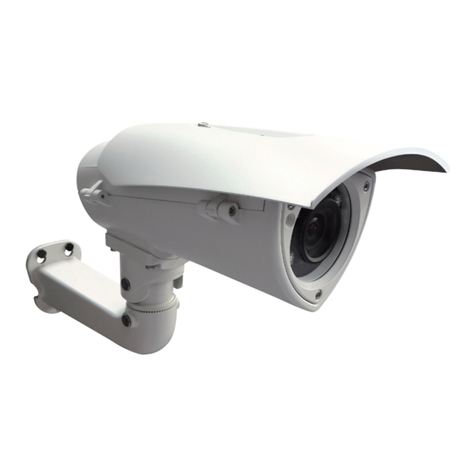
Nexcom
Nexcom NCr-304-VHR user manual
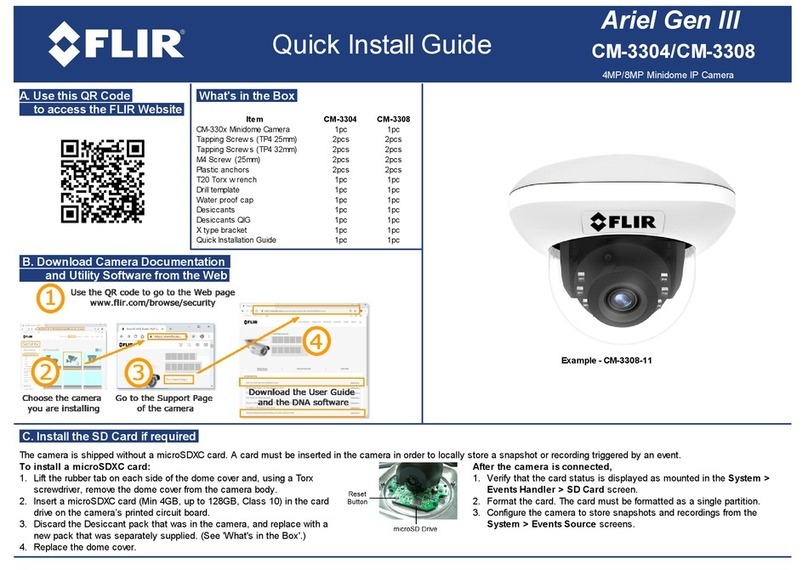
FLIR
FLIR Ariel Gen III CM-3304 Quick install guide
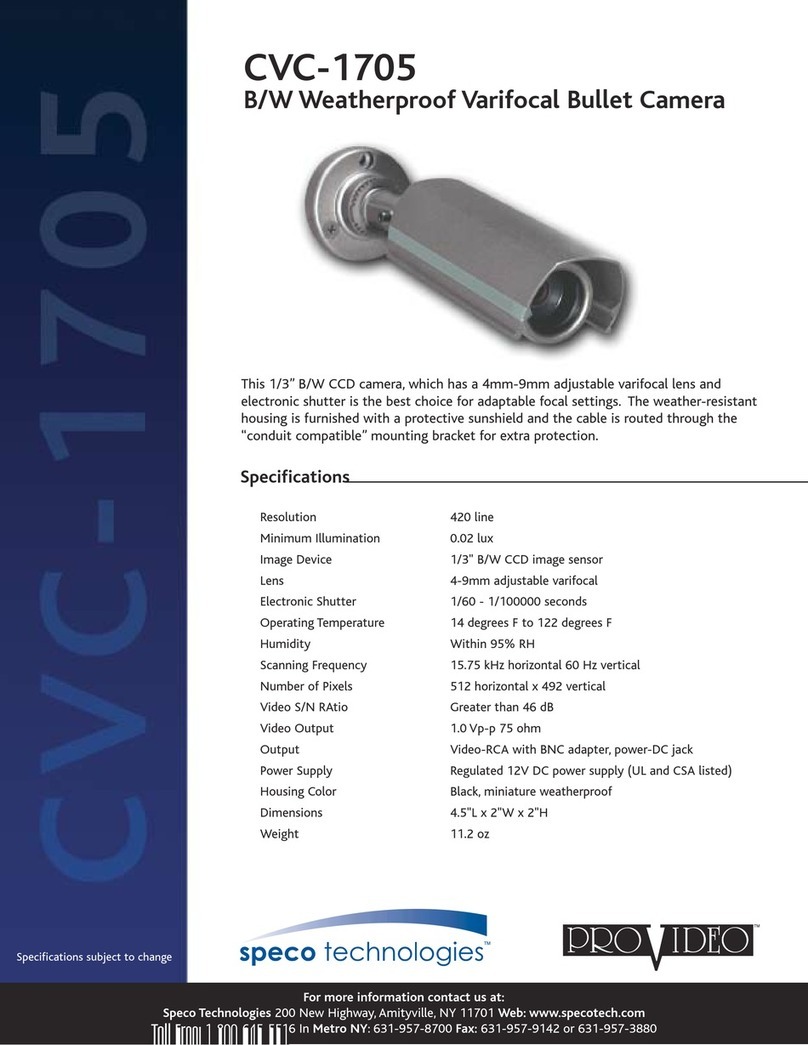
Speco
Speco CVC-1705 Specifications

SECO-LARM
SECO-LARM Enforcer Video Elite Series Specification sheet
